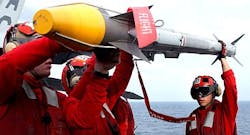Raytheon starts work on latest version of Sidewinder air-to-air missile for Korea and Saudi Arabia
PATUXENT RIVER NAS, Md., 4 April 2012. U.S. Navy aviation officials are awarding the Raytheon Co. Missile Systems segment in Tucson, Ariz., a $97.1 million contract modification for air-to-air missiles and missile training equipment for the governments of Korea and Saudi Arabia.
The contract, awarded late last week by the Naval Air Systems Command at Patuxent River Naval Air Station, Md., calls for Raytheon to provide 139 AIM-9X block II tactical missiles for Korea and Saudi Arabia; 139 block II active optical target detectors for Korea and Saudi Arabia; 33 block II captive air training missiles for Saudi Arabia; and 47 containers for Korea and Saudi Arabia.
The contract combines an $85.3 million purchase for Saudi Arabia and an $11.8 million purchase for Korea under the Foreign Military Sales Act.
| Related stories -- Raytheon AIM-9X Block II missile logs first captive carry flight -- Raytheon to provide AIM-9X missiles for US Navy -- Raytheon moves to full production of AIM-9X missile. |
The AIM-9 Sidewinder is a heat-seeking, short-range, air-to-air missile for fighter aircraft and attack helicopters. AIM stands for air intercept missile. The latest version of the Sidewinder, the AIM-9X, entered service in November 2003, largely in response to the advanced Russian AA-11 Archer missile and advanced Russian infrared countermeasures.
The AIM-9X uses an imaging infrared focal plane array (FPA) seeker with 90-degree off-boresight capability, compatibility with helmet-mounted displays such as the Joint Helmet Mounted Cueing System (JHMCS), and 3D thrust-vectoring control system for increased turn capability.
With the JHMCS, pilots can lock the AIM-9X missile's seeker on to targets simply looking at them. The AIM-9X provides improved look-down-into-clutter -performance against the infrared countermeasures. The block II version of the missile adds lock-on-after-launch capability with a datalink, so pilots can launch the missile first and then direct it to its target afterwards.
For more information contact Raytheon Missile Systems online at www.raytheon.com/businesses/rms, or Naval Air Systems Command at www.navair.navy.mil.
Follow Military & Aerospace Electronics and Avionics Intelligence news updates on Twitter
